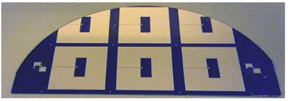Home > Press > Graphene enables tunable microwave antenna
 |
| Photo: Graphene microwave antennae |
Abstract:
Graphene antennae in the microwave part of the spectrum can be tuned by an applied voltage. This is the latest result, published in the renown physics journal Applied Physics Letters, by a pan-European collaboration between Romania, Greece, Italy, and Ireland, using Graphenea graphene.
Graphene enables tunable microwave antenna
San Sebastian, Spain | Posted on May 15th, 2015High-frequency electronics is a complicated matter, due to giant losses that metals and most other conductors suffer at frequencies larger than several 10s of GHz. Electrons that oscillate rapidly experience a sort of friction with the conductor material itself, losing energy to heat. Graphene offers a different platform, in which electrons can oscillate quickly with little loss, due to the peculiar relativistic behavior of charge carriers in graphene. This advantage provided by graphene has resulted in transistors that operate at frequencies up to several terahertz (one terahertz is a thousand gigahertz).
In the microwave part of the spectrum, which is very important for communication, navigation, radar, and radio astronomy, researchers have been looking for the right material to make antennae which can be tuned with an external voltage. Advances have been made using exotic ferroelectrics, ferromagnetics, and liquid crystals, but all those materials, although allowing tunability, exhibited strong losses, preventing efficient microwave antennae.
Now researchers have demonstrated an antenna made from graphene, operating in the microwave part of the spectrum and tunable with external voltage. With a simple fabrication procedure and using a standard CVD graphene layer on a SOI substrate, the researchers show modulation of both the antenna efficiency and its operating frequency in the important X band, just by applying voltage. The antenna behavior is well described with standard microwave modelling tools, allowing for its use as part of more complex circuits.
The research also shows that the antenna, due to its small size compared to the centimeter-long wavelength in this frequency band, radiates in two directions, which could be useful or detrimental, depending on the application. Directionality can be controlled with an added thin reflector layer on the antenna back side. Overall the antenna is less than 1mm thin, with a planar diameter of 4 inches, making it one of the smallest microwave antennas in the world.
The authors of the paper predict that the main applications of this antenna lie in RF communication, where the antenna tunability will allow switching of communication channels. Working in reverse, the antenna could also serve as a radio frequency sensor. Radio frequency and terahertz applications will be among the most prominent uses of graphene, according to the Graphene Flagship application roadmap.
####
For more information, please click here
Contacts:
Marko Spasenovic
Copyright © Graphenea
If you have a comment, please Contact us.Issuers of news releases, not 7th Wave, Inc. or Nanotechnology Now, are solely responsible for the accuracy of the content.
| Related News Press |
News and information
![]() Gene therapy relieves back pain, repairs damaged disc in mice: Study suggests nanocarriers loaded with DNA could replace opioids May 17th, 2024
Gene therapy relieves back pain, repairs damaged disc in mice: Study suggests nanocarriers loaded with DNA could replace opioids May 17th, 2024
![]() Oscillating paramagnetic Meissner effect and Berezinskii-Kosterlitz-Thouless transition in cuprate superconductor May 17th, 2024
Oscillating paramagnetic Meissner effect and Berezinskii-Kosterlitz-Thouless transition in cuprate superconductor May 17th, 2024
Graphene/ Graphite
![]() NRL discovers two-dimensional waveguides February 16th, 2024
NRL discovers two-dimensional waveguides February 16th, 2024
Wireless/telecommunications/RF/Antennas/Microwaves
![]() HKUST researchers develop new integration technique for efficient coupling of III-V and silicon February 16th, 2024
HKUST researchers develop new integration technique for efficient coupling of III-V and silicon February 16th, 2024
Sensors
Discoveries
![]() Diamond glitter: A play of colors with artificial DNA crystals May 17th, 2024
Diamond glitter: A play of colors with artificial DNA crystals May 17th, 2024
![]() Finding quantum order in chaos May 17th, 2024
Finding quantum order in chaos May 17th, 2024
![]() Advances in priming B cell immunity against HIV pave the way to future HIV vaccines, shows quartet of new studies May 17th, 2024
Advances in priming B cell immunity against HIV pave the way to future HIV vaccines, shows quartet of new studies May 17th, 2024
Announcements
![]() Diamond glitter: A play of colors with artificial DNA crystals May 17th, 2024
Diamond glitter: A play of colors with artificial DNA crystals May 17th, 2024
![]() Finding quantum order in chaos May 17th, 2024
Finding quantum order in chaos May 17th, 2024
![]() Oscillating paramagnetic Meissner effect and Berezinskii-Kosterlitz-Thouless transition in cuprate superconductor May 17th, 2024
Oscillating paramagnetic Meissner effect and Berezinskii-Kosterlitz-Thouless transition in cuprate superconductor May 17th, 2024
Research partnerships
![]() Gene therapy relieves back pain, repairs damaged disc in mice: Study suggests nanocarriers loaded with DNA could replace opioids May 17th, 2024
Gene therapy relieves back pain, repairs damaged disc in mice: Study suggests nanocarriers loaded with DNA could replace opioids May 17th, 2024
![]() Discovery points path to flash-like memory for storing qubits: Rice find could hasten development of nonvolatile quantum memory April 5th, 2024
Discovery points path to flash-like memory for storing qubits: Rice find could hasten development of nonvolatile quantum memory April 5th, 2024
![]() Researchers’ approach may protect quantum computers from attacks March 8th, 2024
Researchers’ approach may protect quantum computers from attacks March 8th, 2024
|
|
||
|
|
||
| The latest news from around the world, FREE | ||
|
|
||
|
|
||
| Premium Products | ||
|
|
||
|
Only the news you want to read!
Learn More |
||
|
|
||
|
Full-service, expert consulting
Learn More |
||
|
|
||








